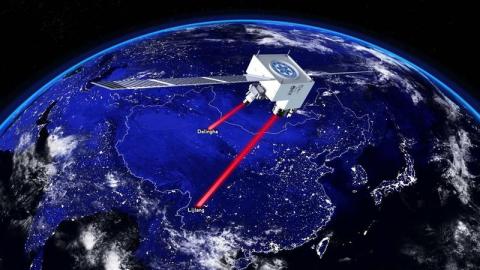Chinese Satellite Breaks a Quantum Physics Record, Beams Entangled Photons From Space to Earth
Chinese scientists have just set a record in quantum physics.
For the first time, pairs of entangled photons have been beamed from a satellite in orbit to two receiving stations almost 1,500 miles away on on Earth.
At the same time, the researchers were able to deliberately separate the entangled photon pairs along a greater distance than has ever been recorded.
The experiment, described Thursday in the journal Science, represents the first measurable proof of an idea that has long been theorized but never tested, experts said.
“This is the first time you have a quantum channel between a satellite and the ground that you can actually use,” said Norbert Lütkenhaus, a professor at the Institute for Quantum Computing at the University of Waterloo in Canada who was not involved in the new work. “People have been talking about doing it for many, many years, but these guys actually did it.”
Keep reading to learn what this new work means, and why it matters.
My quantum physics is kinda rusty. What are entangled photon pairs again?
Great question. For starters, a photon is a tiny particle of light. In fact, it's the smallest unit that light can be broken into. It has no mass and no charge.
Entangled photons are a pair of photons whose properties are linked, and remain that way no matter how far apart they get.
“If you make a measurement on one of the photons, you get a perfectly correlated outcome on the other member of the pair,” Lütkenhaus said.
And that will hold true not matter how many times you look at them.
“One measurement alone doesn’t tell you they are entangled, you need to repeat it many times,” he said. “With entangled photons no matter what you measure, or how many times you measure, or which side of the pair you measure, you always get perfect correlation.”
How is this possible?
Another great question. This one is more difficult to answer.
Scientists have not been able to explain why entanglement occurs. All they know is that it exists.
Einstein referred to the phenomena of entanglement as “spooky action at a distance.” Others have said it is kind of like the physics version of voodoo.
How did the researchers beam entangled photons from space?
They built a special satellite to do it.
The spacecraft, nicknamed Micius after a famous 5th century Chinese scientist, launched in August 2016.
It is loaded with a special crystal that can split a single incoming photon into two daughter photons with joint properties. For this experiment, instruments on the satellite separated the entangled photons and sent them to different receiving stations on Earth.
To do this, Micius had to aim at its targets with an amazing degree of precision, said Jian-Wei Pan, a physicist at the University of Science and Technology of China who led the work.
“It’s the equivalent of clearly seeing a human hair at a distance of 900 feet away,” he said.
Was building a satellite really necessary? That seems kind of extreme ...
It is extreme. And, experts say, challenging.
“Designing, launching and operating a satellite with this capability is no easy feat,” Lütkenhaus said. “I see this as a great engineering triumph.”
But, as the study demonstrates, using a satellite to send beams of entangled photons to Earth is a better strategy than using optical fibers to distribute them.
The greatest distance scientists have been able to separate entangled photons using optical fibers is 62 miles. By sending the entangled photons through space, Pan and his team were able to separate entangled photons by more than 620 miles.
That’s neat, but is this going to affect my life in anyway?
Not immediately, but eventually, it probably will.
For example, distributing entangled photons over large distances could be used to establish unhackable communications via what’s known as quantum cryptography.
This application relies on another strange aspect of quantum mechanics — namely that the simple act of observing a photon disturbs it and causes it to change its orientation.
Scientists have already been able to establish secure, quantum channels using fiber optics, but there is a limit to how far those can stretch.
Using the space-based quantum channel, the authors have shown it is possible to significantly extend the distance over which one can perform such a secure communication, said Jürgen Volz, a physicist at the Vienna Center for Quantum Science and Technology who was not involved in the work.
“In the time of the Internet, when more and more sensitive information is shared and exchanged via the web, this is of tremendous importance,” he said.
But experts say an application like that may still be 10 years away.
What’s going to take so long?
Although the experiment was successful, the rate of sending and receiving entangled photons described in the paper was still quite low. Of nearly 6 million entangled photon pairs generated by Micius each second, only one pair was detected at stations here on Earth.
“The communication rates here are not yet sufficient for a practical application,” said Wenjamin Rosenfeld, a physicist at the Ludwig-Maximilians University in Munich.
However, he added that the mission represents a proof-of-principle demonstration of a quantum communication protocol that could be available in the near future.
Pan put it this way: “This is the first baby step for quantum entanglement experiments going into space. It is really new!”
Deborah Netburn is a science reporter for the Los Angeles Times. She began her journalism career at the New York Observer in 1999, and has covered residential real estate, rich kids in Manhattan, entertainment, home and garden, national news, and technology. She has worked at the Los Angeles Times since 2006. email: deborah.netburn@latimes.com Twitter: @DeborahNetburn.
Get full access to LA Times signature journalism for just 99 cents for the first four weeks.


Spread the word